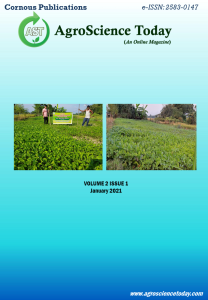Importance of soils to human well-being and cultural enrichment is glorified in the ancient Indian scriptures dating back to the drawn of civilization. In the developing countries like India, a large proportion of the land area shows clear evidence of advanced and continuing degradation seriously affecting the country’s productive resource base. As ecosystem consist of soil, plant, animal and human, an adverse impact on any of the component is likely to have various effects on the other component of system. Continuous adoption of conventional farming practices based on intensive tillage, especially when combined with crop residue burning or removal have exaggerated soil erosion losses and degraded the soil resource base steadily. Soil carbon changes of a crop production system are a very important aspect as it indicates whether a production system is a C restorative process or not. Hence, the need to protect our soil environment against degradation will necessarily involve the knowledge and the use of natural soil functions so as to ensure higher quality soils and better produce quality through the appropriate management of soils.
Looking back the history, to sustain the life, mankind was completely depended on hunting and gathering. When the exponential increase of population started, the food needs also got increased which paved a way for organized agricultural practices with its core focus on food security. Over last few years, the risk of death rates due to famine and food shortages have been decreased gradually but the micronutrient malnutrition status has been increased. It shows that the food needs of the population got its necessary focus whereas the balanced diet didn’t. A balanced diet should contain adequate quantity of macro and micro nutrients that a human requires in a day. The awareness and usage of macronutrients in food has got its importance whereas the micronutrients were often neglected. An attempt has made to furnish the role and importance of micronutrient in soil, plant or human health.
Groundnut is cash crop and most important oil seed in India. Groundnut is grown over an area in India 39.31 lakh ha during 2019-2020. Groundnut crop need well till soil preparation for good extend roots penetrate and increasing the yield. Tillage is a process of field preparation by ploughing and levelling the hard pan of field soil into fine pulverized. In groundnut production primary and secondary tillage operation plays an important role in improving the production through good soil operations. Seed sowing is the process of placing the good quality of viable seeds into soil at optimum depth for its healthier establishment. Weed management plays significant role in improving crop production and productivity by eliminating the crop and weeds competitions. Tractor drawn weeder will cover 4-5 ha day-1 and large area will be weeded in limited time. Groundnut is a single harvest crop and whole field attain maturity at same time. Application of harvester viz., groundnut digger, shaker cum windrower, groundnut fresh pod thresher, groundnut fresh pod stripper, dry pod thresher and groundnut combine harvester can be done. Separation of kernel or seed from the harvested dried pods with fine quality is called decortication. The groundnut mechanization is used to increasing the groundnut production and cost saving operation.
Parasitic nematode, Heterotylenchus autumnalis associated with the face fly, Musca autumnalis, which is deleterious to livestock producers around the world. The parasitic nematode can transmit several eye diseases and parasitic to cattle.
Climate-resilient agriculture is a technique of using existing natural resources in a sustainable manner with agriculture and livestock farming system to achieve increased long-term productivity and farm profits in the view of climate variability. It practices mainly consist of structured methods for managing essential inputs such as land, water, crop production, and livestock management. It appears that inventions and organizations are important in accelerating the adoption of Climate-resilient agriculture practices. In the face of globalization, this practice helps future generations avoid poverty and starvation. These approaches have the potential to implement a new situation and sustain agriculture on a local, regional, and global scale, particularly when done in a sustainable way. Climate-resilient practices lead to increased access to and usage of technology, open trade regimes, increased use of resource management technologies, and enhanced crop and livestock adaptation to extreme forms.
In Karimganj district, fields are remained mostly vacant during Sali rice fallow condition. However, only in few areas are cultivated with Blackgram with local variety. KVK, Karimganj has done extensive and adequate field survey and selected suitable areas for Blackgram cultivation under Cluster Front Line Demonstration (CFLD) Programme during Kharif season of 2019- 2020. A cluster frontline demonstration was taken up with Blackgram variety PU-31. The demonstration was taken up at farmer’s field of Shamakul Roy of Brajendranagar village of Karimganj district of Southern Assam. The success point was barren areas converted into Blackgram grown areas after Sali rice cultivation. The field data on demonstration of PU-31 and farmers’ local variety were recorded. The yield data of PU-31 was recoded as 7.2 q/ha with potential yield of 12.0 q/ha whereas farmers’ variety were recorded as 5.5q/ha. The district yield average was documented as 5.0 q/ha whereas state yield average was 6.0q/ha.
